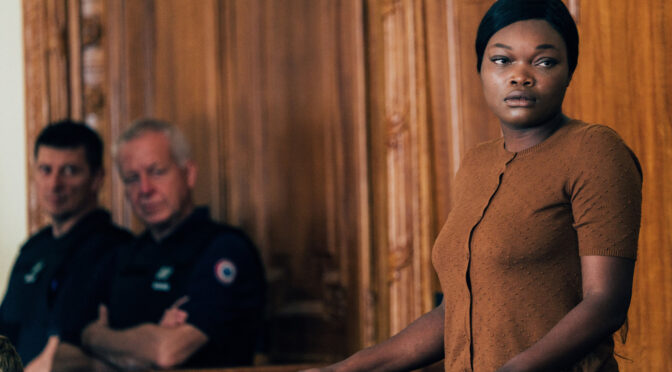It takes a deft hand to communicate empathy in the story of a mother who has killed her 15-month-old baby, but director Alice Diop handles this courtroom drama with grace, even if the genre tag feels reductive here. Laurence Coly is on the stand, having left her child on a beach to be taken by the sea. Rama sits and takes notes, a literature professor using the case as inspiration for a retelling of the Medea myth. She often appears on the verge of tears, eyes cast downward, first to take notes, later in solemn contemplation. As the trial continues, there comes to exist an understanding of sorts between the women.
Diop followed the real-life case of Fabienne Kabou, who committed the same crime as the fictional Laurence. SAINT OMER draws heavily from the trial, using courtroom transcripts for its dialogue. Having worked predominantly in documentary, Diop masterfully uses fiction to convey the truth of a complex situation, which involves a woman who admits to her actions but cannot identify the reason behind them. Much of the film has Laurence’s face front and centre, a captivating performance by Guslagie Malanda. She communicates to the audience something that never cuts through to those in the room with her; that for the white judge, jury and lawyers, her Senegalese heritage is at odds with her well-spoken French. They aren’t just confused by her actions, but by how she recounts the last few years of her life and all the factors that led to her imprisonment. She wonders what part sorcery has played in her misfortune, which is flagged as a sign of madness. However, sorcery is defined differently depending on where you are in the world and means something different to Laurence than to those questioning her. That difference – in culture, in heritage, in language – others her in the eyes of the court. Despite her well-articulated testimony, words are not enough to bring everyone else into her worldview.
“…difference – in culture, in heritage, in language – others her in the eyes of the court. Despite her well-articulated testimony, words are not enough to bring everyone else into her worldview.”
As Kayije Kagame’s Rama observes Laurence, she reflects on her own perceptions of identity and motherhood. The two Black women, along with Laurence’s mother Odile, stand out in a predominantly white courtroom. The distance between Rama, born in France to immigrant parents, and her own mother becomes a consuming concern. She and her mother are shown in flashback wearing contrasting clothes, daughter in jeans, mum in Senegalese dress and jewellery, never sharing a word. Distance is at the heart of the film: familial relationships in which nothing is said, cultural differences in which gaps are not bridged.
A third-act monologue by Laurence’s lawyer is directed at the jury and, in turn, us. Looking into the camera, she touches on the inescapable spirituality and biology of motherhood. In a film about what keeps us apart, it is a raw moment that focuses instead on what cannot help but bond women to their parents and their children. Rama’s anxieties reflect off Laurence and her mother, worried about ending up like them, about whether she has any control over the matter, about her white partner understanding something integral to her feeling of selfhood.
“In a film with swathes of dialogue, it is Kagame and Malanga’s faces that convey the story’s deeper emotions, communicating what words fail to, with subtle responses to alienating questions and the way their eyes seek an ally.”
In a film with swathes of dialogue, it is Kagame and Malanga’s faces that convey the story’s deeper emotions, communicating what words fail to, with subtle responses to alienating questions and the way their eyes seek an ally. While the criminality is never in question, SAINT OMER is a film in which its key players long for comfort on a level too deep for them to have found from the people in their lives. It is a remarkable and patient piece of work, with a resolution far more profound than any did-she-or-didn’t-she could ever be.

